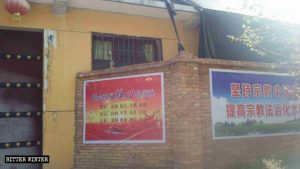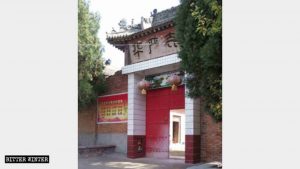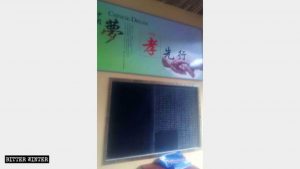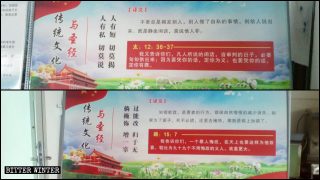
The march to establish religion “with Chinese characteristics” continues, with Buddhist temples now feeling the pressure, compromising their beliefs.
The authorities in the northwestern province of Shaanxi have ordered Buddhist temples to include nationalist ceremonies and propaganda in their services and on their property. Temples are gradually being brought under the authorities’ control, pushing religious belief towards “sinicization.”
Typical of the government’s push is the example of Baoji city in Shaanxi. On October 6, 2018, the Religious Affairs Bureau of the city convened a meeting on religion at Yucai Hotel in Chencang district, and demanded that local temples fly the national flag, hold a flag-raising ceremony, and sing the national anthem. One participant reported that the United Front Work Department (UFWD) issued an official “red header” document in October, demanding that existing religions be transformed into faiths “with Chinese characteristics.”
About a week later, officials from the city’s Religious Affairs Bureau, Civil Affairs Bureau, and UFWD arrived at Chencang district’s Huayan Temple to implement the flag-raising policy. The temple’s master (“master” is an honorific title for Buddhist monks and nuns), who is in her eighties, was required personally to dig a pit and build a cement stand to raise the flag. The master refused on the grounds of her advanced age.
“You have to dig the pit no matter what,” a government official replied.

The flag pole has been eventually erected, and in late October, the temple held a flag-raising ceremony presided over by the local village chief.
One monk said helplessly, “If you don’t implement its [government’s] mandates, they will persecute you. Originally, leaving home to practice Buddhism was in pursuit of tranquility. Now, the state tells you to do this and do that, preventing you from getting any peace.”
Buddhist temples are not the only religious institutions suffering under the “sinicization” policy. On July 31, 2018, the 6th Joint Conference of the Country’s Religious Groups issued a joint statement calling for the adoption of nine specific practices to be adopted in religious venues, including organizing flag-raising ceremonies. The document demands that religious communities and individual believers strengthen national and civic awareness, and that they link their own destiny with that of the Party and the state.
Subsequently, Chinese flags have been raised at religious venues throughout the country. The national flag has even been raised at the famous 1,500-year-old Shaolin Temple.
The push to “sinicize” Buddhist temples is widespread. On October 23, Huguo Jile Temple in Chencang district also raised the national flag in front of the temple. In addition, the “Core Socialist Values” and other propaganda slogans were posted all over the temple’s walls.
On November 3, when the temple held an eye-opening ceremony (a ceremony for consecrating new statues of Buddha or other deities), the national anthem was played first. Government officials from the city’s UFWD, Religious Affairs Bureau, and Civil Affairs Bureau also participated in the ceremony. The authorities even deployed special police to maintain order.
The message of the authorities overseeing the ceremony was clear. “No matter what you believe, you must abide by national policies. You must love your country first, and only then can you love your religion,” said an official from the UFWD. “The national flag is the symbol of the Chinese people. The concrete manifestation of patriotism is to raise the national flag.”
The threat of the new “sinicization” policies to religion was also clear. “Raising the national flag at the temple symbolizes that the temple is under the control of the state. Whatever they tell you to do, you have to do it,” said one local monk. “If you disobey, you will be arrested.”
One local Buddhist believer said that the government is doing these things at the temple to force people to deviate from their true faith.
On October 27, Yunliang Temple in Muyi town, in Chencang district, held a flag-raising ceremony presided over by the village secretary. They have also been forced to hang posters that say, “Persist in the ‘sinicization’ of religion; improve the law-based governance of religion,” and other propaganda signs on the temple’s walls.
In an interview, professor Sen Nieh of the Catholic University of America said that the reason for the current religious chaos in mainland China is that the Communist Party forces people with religious beliefs to listen to the Party first and foremost, claiming that the Communist Party is their true leader.



Source:Bitter Winter / Zhou Xiaolu



